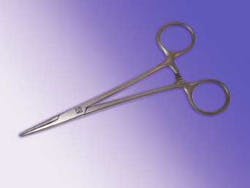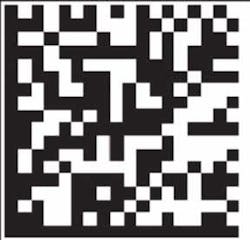Improving product tracking
With laser-produced ID matrix codes traceablity is made easier
How do you mark a circuit board or a medical component with a manufacturer’s identification, part number, and lot and date codes when the marking area is only slightly larger than a pinhead? The answer-ID matrix codes.
For traceability, authenticity verification, and critical identification, more industries are turning to direct part marking with ID matrix codes to replace bar codes (see Figure 1). Primarily the electronic, automotive, aerospace, and medical industries have the greatest needs. Because of its small size and large information capacity, 2D matrix symbology is leading the way in these industries.
The matrix code, unlike regular codes or stacked bar codes, is made up of individual elements or cells of equal size. These cells form a matrix similar to a checkerboard. Most often this matrix is square, but elongated rectangular codes are sometimes used if the space available is restricted in one dimension. The information is stored in the matrix by the selective placement of the black and white (or dark and light) cells. Because this matrix can be made dense, a large amount of information can be held in a very small area (see Figure 2), the largest matrix storing thousands of characters.
Such codes can be printed directly onto product or product packaging in a variety of ways, but probably the most flexible is laser, with several distinct advantages.
The resolution of a laser mark is five to ten times higher than other methods. This is particularly significant for 2D matrices as the amount of information that can be stored increases by the square of the resolution; meaning up to 100 times the data can be encoded in the same physical area. Also, as a non-contact marking method, the laser beam “tool” cannot become blunt over time as in dot peen and there are no nozzles to block as in ink jet, so there is no degradation of the mark even after many thousands of cycles.
Laser-marked codes tend to be permanent and can stand up to aggressive cleaning processes such as autoclaving. This is obviously vital for medical devices such as surgical instruments (see Figure 2) where ID matrices are used for life cycle traceability. Also in the medical industry, foreign material like ink on implantables can cause bio-compatibility problems and laser marking is often preferred. Other marking methods can damage the surface, creating potential hiding places for bacteria. Depending on the substrate, a laser can be configured to create a permanent, high-contrast mark with no surface damage.
A laser can mark many different materials with usually only a few changes of software parameters meaning complete assemblies can often be marked in one operation.
Lasers do not use expensive consumables such as inks or solvents offsetting the relatively high capital cost in a surprisingly short time. They require only occasional maintenance, increasing uptime and again reducing long-term costs.
In the electronics industry, as devices become ever smaller, space constraints are more severe. This is where the superior resolution of a laser mark compared to other methods comes into its own, allowing smaller marks and more information to be encoded onto ICs and packed printed circuit boards. Laser marking also offers the possibility to mark codes on assembled boards, on different materials, and within recesses in one operation.
Manufacturers of jet engine components and other parts used in the aerospace industry are adopting direct part marking in order to meet the objectives of the ATA SPEC 2000 directive. A permanent mark is required for these applications, like dot peen or laser marking. Dot peen marking demands large forces to be applied on the part, leading to mechanical stress and requiring heavy and expensive fixturing. For the same reasons, laser is the preferred method for marking thin section or delicate parts.
Automotive manufacturers use direct part marking with ID matrices to track parts through the plant, enabling them to reduce inventory, eliminate assembly errors and trace quality problems. The laser can receive serial numbers or similar information directly from production control computer systems to enable seamless integration into the production line. Motorsport teams use ID matrices to identify parts for lifetime tracking, and many teams now employ laser marking because the surface damage caused by other methods can form propagation sites for cracks leading to premature failure of the part.
A two-dimentional reading device em- ploying a CCD camera is needed to read the codes. These are readily available from a variety of sources. Laser marks are generally regarded as easier to read by manufacturers of these devices because they tend to offer higher contrast than other methods.
When considering a laser marker, bear in mind that the most suitable laser source will be largely determined by the materials to be marked, although budget and environment do have an influence. The main types of laser sources include the Nd:YAG (diode- or lamp-pumped), Nd:YVO4 (Vanadate), and CO2. A reputable laser manufacturer will be able to offer a choice of technologies and power outputs as well as advise on the best solution and even process samples.
Mike Batchelor, with Rofin-Baasel UK Ltd, Daventry, Northants, UK, can be contacted by e-mail at [email protected].



